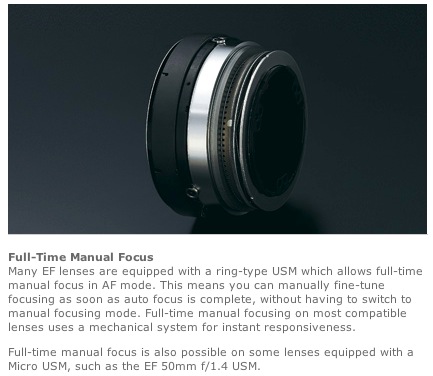A handy tool.
One of the less well publicized aspects of many Canon lenses (and probably equally applicable to those from the competition – I have no axe to grind for Canon) is the Full Time Manual Focus function.
Canon describes it well:

Because the center focus point in the 5D (the most sensitive one) I use is more accurate and faster than anything I have used before – yes, including a well adjusted Leica M rangefinder – I tend to use the focus-recompose technique when critical focus is needed. For example, in a studio portrait, I will focus on the eyes, take a first shutter release pressure to lock the focus and recompose. Click. This is an essential technique when the object of focus is off center and I am not about to trust area/matrix/whatchyoumacallit focusing to guess the primary focus point. Equally, I am not going to use the 5D’s ability to select the focus point on the screen, as the central autofocus sensor is more sensitive than the peripheral ones. Why compromise?
However, there is an alternative and I don’t mean switching the lens to Manual. Many Canon lenses offer something named Full Time Manual Focus, meaning that you leave the lens on Autofocus but make final focus adjustments with the focusing collar on the lens. As long as you hold on to the collar and maintain first shutter release pressure, autofocus is overridden by your manual setting. The technique works especially well with the 400mm f/5.6, where ‘focus and recompose’ is often tricky owing to the small field of view and substantial bulk of the lens.
By the way, Canon makes a selection of interchangeable focusing screens for many of their DSLRs, including the 5D. Some of these allegedly make manual focusing easier, though I prefer to stick with the stock screen. Changing screens is not something you want to do every day.
Have a look at this link – quite old this but interesting
It’s amazing how simple and elegant the USM motor is and how the FTM works.